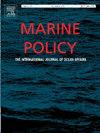Applying a regional certification scheme for aquatic invasive species fishery: The case of blue crab (Callinectes sapidus) in the northern Adriatic Sea
IF 3.7
2区 社会学
Q2 ENVIRONMENTAL STUDIES
引用次数: 0
Abstract
Certification schemes are increasingly applied in fisheries and aquaculture to promote sustainability, traceability, and responsible sourcing. However, their application to the management and exploitation of edible aquatic invasive species (AIS) remains largely unexplored. This study represents the first attempt to assess how a regional certification framework, the Adriatic Responsible Fisheries Management (ARFM) scheme, can be adapted to a fishery targeting an AIS in the Mediterranean. We focus on the case of the Atlantic blue crab (Callinectes sapidus), an invasive predator that has recently proliferated in the coastal lagoons of the northern Adriatic Sea, causing considerable ecological and economic damage, particularly to clam farming systems. To evaluate whether C. sapidus fishery aligns with ARFM certification criteria, we gathered knowledge through interviews with small-scale fishers who have developed and implemented innovative gears to control and commercially exploit the species. Our assessment found that, under current management, the C. sapidus fishery does not meet all ARFM certification requirements. Certification could only be achieved if an action plan is adopted addressing key challenges such as the absence of dedicated regulations, the need for harvest control rules, and the implementation of systematic data collection and monitoring. Our findings highlight both the opportunities and obstacles in integrating an edible AIS into responsible seafood markets, and illustrate how the ARFM scheme can guide necessary improvements towards sustainable and certified exploitation. This case study provides a valuable model for developing adaptive harvest strategies for edible AIS in the Mediterranean, where biological invasions are increasingly reshaping coastal fisheries.
水生入侵物种渔业区域认证制度的应用——以亚得里亚海北部蓝蟹为例
认证计划越来越多地应用于渔业和水产养殖,以促进可持续性、可追溯性和负责任的采购。然而,它们在可食用水生入侵物种(AIS)管理和开发中的应用仍未得到充分开发。这项研究是第一次尝试评估如何使亚得里亚海负责任渔业管理(ARFM)计划这一区域认证框架适用于地中海针对AIS的渔业。我们关注的是大西洋蓝蟹(Callinectes sapidus)的案例,这是一种侵入性捕食者,最近在亚得里亚海北部的沿海泻湖激增,造成了相当大的生态和经济破坏,特别是对蛤蜊养殖系统。为了评估sapidus渔业是否符合ARFM认证标准,我们通过与小规模渔民的访谈收集了知识,这些渔民已经开发并实施了创新的装备来控制和商业开发该物种。我们的评估发现,在目前的管理下,棘鱼渔业不符合ARFM认证的所有要求。只有通过一项行动计划,解决诸如缺乏专门法规、需要采收控制规则以及实施系统数据收集和监测等关键挑战,才能获得认证。我们的研究结果强调了将可食用AIS纳入负责任的海鲜市场的机遇和障碍,并说明了ARFM计划如何指导对可持续和认证开发的必要改进。本案例研究为开发地中海可食用AIS的适应性捕捞策略提供了一个有价值的模型,在地中海,生物入侵正日益重塑沿海渔业。
本文章由计算机程序翻译,如有差异,请以英文原文为准。
求助全文
约1分钟内获得全文
求助全文
来源期刊

Marine Policy
Multiple-
CiteScore
7.60
自引率
13.20%
发文量
428
期刊介绍:
Marine Policy is the leading journal of ocean policy studies. It offers researchers, analysts and policy makers a unique combination of analyses in the principal social science disciplines relevant to the formulation of marine policy. Major articles are contributed by specialists in marine affairs, including marine economists and marine resource managers, political scientists, marine scientists, international lawyers, geographers and anthropologists. Drawing on their expertise and research, the journal covers: international, regional and national marine policies; institutional arrangements for the management and regulation of marine activities, including fisheries and shipping; conflict resolution; marine pollution and environment; conservation and use of marine resources. Regular features of Marine Policy include research reports, conference reports and reports on current developments to keep readers up-to-date with the latest developments and research in ocean affairs.
 求助内容:
求助内容: 应助结果提醒方式:
应助结果提醒方式:


